Kitchenware 'n Candybars
페이지 정보

본문
There are many types of parallel ports, but the term has become most closely associated with the printer port or Centronics port found on most personal computers from the 1970s through the 2000s. It was an industry de facto standard for many years, and was finally standardized as IEEE 1284 in the late 1990s, which defined the Enhanced Parallel Port (EPP) and Extended Capability Port (ECP) bi-directional versions. An Wang, Robert Howard and Prentice Robinson began development of a low-cost printer at Centronics, a subsidiary of Wang Laboratories that produced specialty computer terminals. Switch to another device and disconnect your router from the computer that you are using for internet access. The physical phenomena on which the device relies (such as spinning platters in a hard drive) will also impose limits; for instance, no spinning platter shipping in 2009 saturates SATA revision 2.0 (3 Gbit/s), so moving from this 3 Gbit/s interface to USB 3.0 at 4.8 Gbit/s for one spinning drive will result in no increase in realized transfer rate. While a serial port does so with the minimum of pins and wires, it requires the device to buffer up the data as it arrives bit by bit and turn it back into multi-bit values.
Due to the height restriction imposed by the overhead wires, double-stacked container trains have been traditionally difficult and rare to operate under electrified lines. Costs are especially high when tunnels, bridges and other obstructions have to be altered for clearance. If the entire network is electrified, diesel infrastructure such as fueling stations, maintenance yards and indeed the diesel locomotive fleet can be retired or put to other uses - this is often the business case in favor of electrifying the last few lines in a network where otherwise costs would be too high. Electrification cost: electrification requires an entire new infrastructure to be built around the existing tracks at a significant cost. However, this limitation is being overcome by railways in India, China and African countries by laying new tracks with increased catenary height. Overall, China takes first place, with around 100,000 km (62,000 mi) of electrified railway, followed by India with over 60,000 km (37,000 mi) of electrified railway, and continuing with Russia, with over 54,000 km (34,000 mi) of electrified railway. Whatever the causes of the sparks effect, it is well established for numerous routes that have electrified over decades.

Newly electrified lines often show a "sparks effect", whereby electrification in passenger rail systems leads to significant jumps in patronage / revenue. Traditionally IBM PC systems have allocated their first three parallel ports according to the configuration in the table below (if all three printer ports exist). This was accomplished by allowing the data lines to be written to by devices on either end of the cable, which required the ports on the host to be bidirectional. Maintenance costs of the lines may be increased by electrification, what is control cable but many systems claim lower costs due to reduced wear-and-tear on the track from lighter rolling stock. Fragility and vulnerability: overhead electrification systems can suffer severe disruption due to minor mechanical faults or the effects of high winds causing the pantograph of a moving train to become entangled with the catenary, ripping the wires from their supports. Theft: the high scrap value of copper and the unguarded, remote installations make overhead cables an attractive target for scrap metal thieves. MOM'S SPATULA Designer : Pardo The ol' standby spatula: square flat metal head riveted to a flat metal handle, with a two-part painted wooden insulating grip. Performance was further improved by using the buffer to store several lines and then printing in both directions, eliminating the delay while the print head returned to the left side of the page.
5V to represent a 1. When the data was ready, the host pulled the STROBE pin low, to 0 V. The printer responded by pulling the BUSY line high, printing the character, and then returning BUSY to low again. The parallel port interface was originally known as the Parallel Printer Adapter on IBM PC-compatible computers. In computing, a parallel port is a type of interface found on early computers (personal and otherwise) for connecting peripherals. It was primarily designed to operate printers that used IBM's eight-bit extended ASCII character set to print text, but could also be used to adapt other peripherals. To improve performance, printers began incorporating buffers so the host could send them data more rapidly, in bursts. Today, the parallel port interface is virtually non-existent in new computers because of the rise of Universal Serial Bus (USB) devices, along with network printing using Ethernet and Wi-Fi connected printers. This also applies when bus routes with diesel buses are replaced by trolleybuses. As usuall all our Spatulas are guaranteed not to rust, bust, break down, or fuss. You have a model of economic growth that has broken down, comprehensively broken down. Electric trains have a higher power-to-weight ratio (no onboard fuel tanks), resulting in fewer locomotives, faster acceleration, higher practical limit of power, higher limit of speed, less noise pollution (quieter operation).
- 이전글Master (Your) 到府外燴 in 5 Minutes A Day 24.08.07
- 다음글The Walking Dead: Season One - [Взлом/МОД Меню] на Андроид 24.08.07
댓글목록
등록된 댓글이 없습니다.
